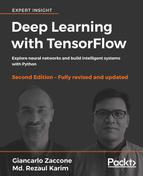TensorFlow is designed to make predictive analytics through ML and DL easy for everyone, but using it does require a decent understanding of some general principles and algorithms. The latest release of TensorFlow comes with lots of exciting new features, so we have tried to cover them so that you can use them with ease. In summary, here is a brief recap of the key concepts of TensorFlow that have been explained in this chapter:
- Graph: Each TensorFlow computation can be represented as a data flow graph, where each graph is built as a set of operation objects. There are three core graph data structures:
tf.Graph(https://www.tensorflow.org/api_docs/python/tf/Graph),tf.Operation(https://www.tensorflow.org/api_docs/python/tf/Operation), andtf.Tensor(https://www.tensorflow.org/api_docs/python/tf/Tensor). - Operation: A graph node takes one or more tensors as input and produces one or more tensors as output. A node can be represented by an operation object for performing computational units such as addition, multiplication, division, subtraction, or more complex operations.
- Tensors: They are like high-dimensional array objects. In other words, they can be represented as edges of a data flow graph and are the outputs of different operations.
- Session: A session object is an entity that encapsulates the environment in which operation objects are executed for running calculations on the data flow graph. As a result, tensor objects are evaluated inside a
run()oreval()invocation.
In a later section of the chapter, we introduced TensorBoard, which is a powerful tool for analyzing and debugging neural network models. Finally, we saw how to implement one of the simplest TensorFlow-based linear regression models on a fake and a real dataset.
In the next chapter, we will discuss the theoretical background of different FFNN architectures such as Deep Belief Networks (DBNs) and Multilayer Perceptron (MLP).
We will then show how to train and analyze the performance metrics that are needed to evaluate the models, followed by some ways to tune hyperparameters for FFNNs for optimized performance. Finally, we will provide two examples, using MLP and DBN, of how to build very robust and accurate predictive models for predictive analytics on a bank marketing dataset.
